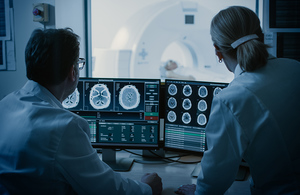The integration of artificial intelligence (AI) into healthcare, particularly in radiology, showcases both the potential and the challenges of automation in medical diagnostics. A notable case study involves the collaboration between Roke and the NHS, focusing on enhancing the evaluation of computerized tomography (CT) scans. This initiative illustrates the tangible benefits of AI while providing a wealth of insights for small and medium-sized business (SMB) leaders and automation specialists who may be evaluating similar tools for their operational needs.
At George Eliot Hospital NHS Trust, an institution serving over 300,000 individuals, radiologists conduct approximately 60 scans daily, many of which pertain to cancers. A cornerstone of effective cancer diagnosis is the comparison of recent scans to prior ones; however, the current manual process is labor-intensive and prone to inconsistencies. The absence of automation tools complicates the alignment and overlay of scans, resulting in prolonged diagnostic times and, in some instances, compromised patient safety.
The AI-driven solution, implemented by Roke, was designed to facilitate the automatic overlay of CT images to streamline this comparison process. This approach compensates for several inherent variables, such as patient movement and breathing, as well as variations in body composition—factors that can obfuscate accurate assessments. By employing a proof of concept developed over just 12 weeks, Roke demonstrated how AI could potentially revolutionize radiological evaluations.
From a tool comparison perspective, the Roke solution stands out for its ability to intelligently assess anomalies in a three-dimensional context, allowing for the identification of subtle changes in lesion volume or the emergence of new lesions. This is achieved through machine learning algorithms trained on a dataset of 100 anonymized CT scans, which included vital positional data, thus enhancing the overall robustness of the tool. A key strength of this approach lies in its capacity to deliver increased diagnostic accuracy alongside reduced workload for radiologists—resulting in expedited diagnoses and improved patient outcomes.
However, while AI solutions offer significant upside, they also come with notable limitations. For instance, the initial costs associated with developing and implementing such a system can be substantial. Continued investment in training and refinement of the AI algorithms is essential to ensure ongoing effectiveness in diverse patient scenarios. Moreover, the use of sensitive patient data raises privacy and ethical concerns that organizations must navigate meticulously. In considering alternatives like Zapier or Make for automation tasks in other domains, the trade-offs often involve comparing ease of use and integration capabilities against the potential depth of insights and automation provided through AI technologies like Roke’s CT scan solution.
The return on investment (ROI) for Roke’s solution is potentially profound. In validation tests, lesions were successfully detected in 7 out of 9 patients, and 10 out of 17 images. This level of accuracy not only speaks to the tool’s effectiveness but directly correlates with improved patient safety and quicker treatment pathways—an essential aspect of optimizing healthcare outcomes. For SMB leaders, the implications are clear: investments in robust AI solutions can yield substantial long-term benefits, even if the initial costs appear daunting.
Scalability is another vital consideration for businesses evaluating automation tools. Roke’s AI solution is adaptable to varying sizes of data sets and can potentially be scaled to other hospital systems or medical imaging technologies, further enhancing its utility across the healthcare landscape. Businesses might weigh this against tools like OpenAI and Anthropic, which serve broader sectors but may not provide the specialized depth or regulatory compliance necessary in healthcare applications. The challenge is to find balances between general tools that are cost-effective and specialized solutions that may be more impactful but also require more substantial investments and development.
In summary, while the incorporation of AI into healthcare settings such as radiology presents numerous advantages, it also necessitates comprehensive analysis across various dimensions, including cost, effectiveness, and applicability. SMB leaders and automation specialists must evaluate these factors closely against their operational requirements and long-term objectives.
Ultimately, the experience gained from the Roke and NHS partnership provides critical lessons in how AI can optimize complex processes. Leading with data-driven insights enhances not only diagnostic capabilities but also fosters a culture of innovation within organizations aiming to leverage technology for improved outcomes.
FlowMind AI Insight: The ongoing evolution of AI tools in healthcare highlights the critical need for organizations to balance cost with functionality. As AI technology advances, SMB leaders must prioritize tools that offer both immediate operational benefits and scalable solutions that can grow with their needs.
Original article: Read here
2022-12-19 08:00:00

